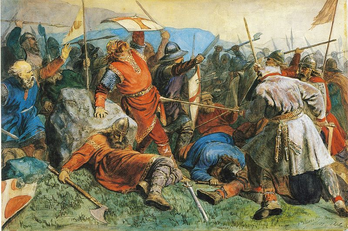
Sigrod falls during the Battle of Haugar
The Battle of Haugar was the culmination of the struggle between Eirik and his half-brothers Olaf and Haakon for the crown of Norway.
Harald Fairhair had set many of his children as sub-kings over the numerous kingdoms he had conquered during the 9th century. Of this brood, Eirik, the oldest as far as the records are concerned, was considered the favourite and was designated Harald's heir. However his half-brothers were jealous and frequently fought amongst themselves for favour, power and wealth.
Eirik succeeded his father as High King of Norway in 930 and soon proved a more onerous ruler, demanding ever greater taxation from his brothers. Eventually Bjorn Farmann, sub-king of Vestfold, was murdered in 934 by Eirik after quarrelling about Eirik's share of Viken's booming trade. Olaf Geirstadalf, king of Vingulmark, swore to avenge his brother and slowly this broke out into open warfare.
Eirik could rely on support from his lords in Western Norway, at least he could until the murder of another half-brother Ragnvald, king of Hadeland, which made Sigrod Haraldson, king of Trondheim, switch his alleigence. Olaf meanwhile quickly assumed leadership of Eastern Norway. Yet another brother, the young Haakon who had been staying in Wessex, heard of the strife and began preparations of his own with the blessing of his protector the king of Wessex, Aethelstan. After a summer of small skirmishes Eirik met the forces of Olaf and Sigrod at Haugar in Vestfold. Sigrod fell in battle but Olaf proved too strong for Eirik and he was forced to fall back. News of Haakon's landing at Trondheim robbed Eirik of what little authority remained and gathering what men, ships and wealth he could he fled to kin in Jorvik.
The sagas rejoice in the explusion of Eirik and are quick to proclaim both Olaf and Haakon as wise and just rulers. A hastely put together agreement divided Eirik's realms between them; Olaf gaining the entire Viken, Haakon; the western lands which he would conquer (and re-conquer). Sigrod's lands fell to the Earl of Lade who had done the most to smooth Haakon's success in seizing Eirik's territory. The sub-kingdoms were quietly reduced to earldoms.
However what may have appeared on the surface to be a velvet divorce of Norway into Hordaland, Viken and Lade, actually masked the slow poisoning of relations between the three. And as the families of the sub-kings were slowly pushed out of power, or Haakon tried to impose christianity on an unreceptive populace, it led to a second great exodus out of the norwegian fjords. Eirik in exile in Jorvik found himself at the head of an ever growing viking horde perfectly capable of resisting Wessex's attempts to regain authority over the kingdom, as well as threatening the other Norse lords of Man and Dublin. Other dispossessed lords moved into Gothenland accentuating the power struggles there, but also providing a counter-balance to the inroads Danish and Svealandic kings were making. And finally the outward pledge of peace between Haakon and Olaf broke down almost immediately. The nascent kingdoms were at each other's throats for the homage of those lords on the borders with little respect for old rights or privileges
| ||||||||||||||||||||

